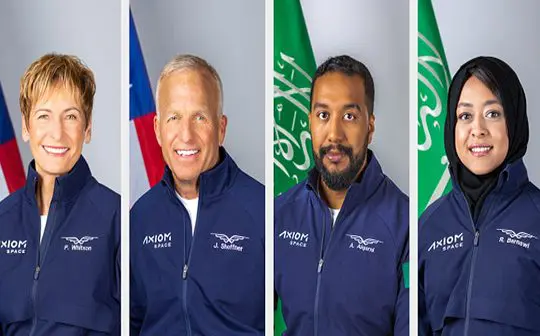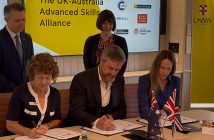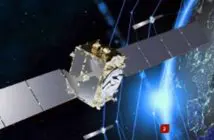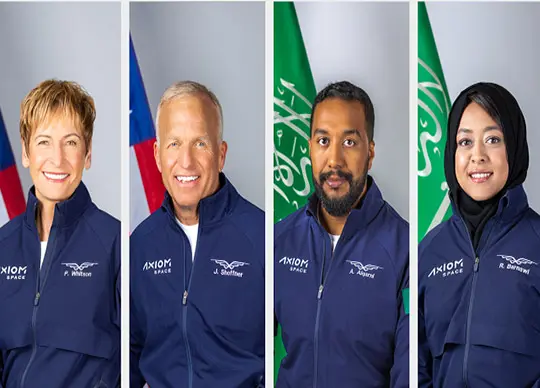
NASA and its international partners have approved the crew for Axiom Space’s second private astronaut mission to the International Space Station, Axiom Mission 2 (Ax-2).
Axiom Space’s Director of Human Spaceflight and former NASA astronaut Peggy Whitson will command the privately funded mission. John Shoffner of Knoxville, Tennessee, will serve as pilot. The two mission specialists, Ali Alqarni and Rayyanah Barnawi from the Kingdom of Saudi Arabia (KSA), are members of the inaugural Saudi national astronaut program. They are flying through an arrangement between KSA and Axiom Space.
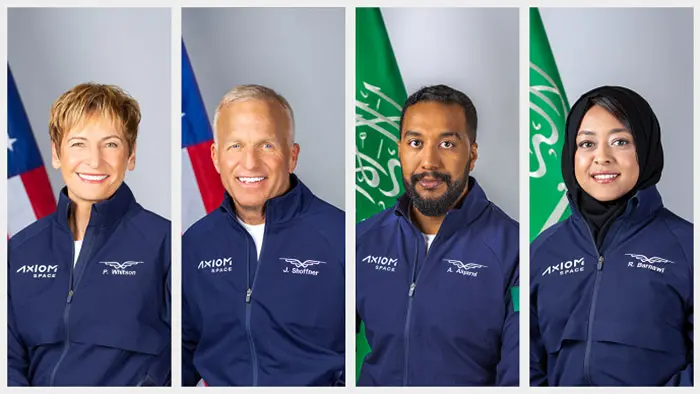
Image: Crew members for the second private astronaut mission to the International Space Station, Axiom Mission 2 (Ax-2), left to right: Commander Peggy Whitson, Pilot John Shoffner, and Mission Specialists Ali Alqarni and Rayyanah Barnawi. Credits: Axiom Space.
“Enabling more people to go to space is an important component of NASA’s continuing efforts to grow the low-Earth orbit economy,” said Angela Hart, manager of NASA’s Commercial Low-Earth Orbit Development Program. “Private astronaut missions are a key component to enable a successful transition to a model of commercially owned and operated platforms in low-Earth orbit. I appreciate the commitment of our International Space Station and commercial partners to help us achieve this future.”
The Ax-2 crew will launch from NASA’s Kennedy Space Center in Florida aboard a SpaceX Dragon spacecraft and travel to the space station. Once docked, the private astronauts plan to spend 10 days aboard the orbiting laboratory implementing a full mission of science, outreach, and commercial activities. The mission, targeted for launch in spring 2023, will be the first private space mission to include both private astronauts and astronauts representing foreign governments, as well as the first private mission commanded by a woman.
“Axiom Space’s second private astronaut mission to the International Space Station cements our mission of expanding access to space worldwide and supporting the growth of the low-Earth orbit economy as we build Axiom Station,” said Michael Suffredini, president and CEO of Axiom Space. “Ax-2 moves Axiom Space one step closer toward the realization of a commercial space station in low-Earth orbit and enables us to build on the legacy and achievements of the station, leveraging the benefits of microgravity to better life on Earth.”
Whitson will become the first female commander of a private space mission, adding to her prior accomplishments, including as NASA’s chief astronaut and the first female commander of the space station. In addition, she will add to her standing record for the longest cumulative time in space by a NASA astronaut.
“I’m honored to be heading back to the station for the fourth time, leading this talented Ax-2 crew on their first mission,” said Whitson. “This is a strong and cohesive team determined to conduct meaningful scientific research in space and inspire a new generation about the benefits of microgravity. It’s a testament to the power of science and discovery to unify and build international collaboration.”
Shoffner, a businessman, has always had an interest in space, the stars, and flying, becoming a pilot at the age of 17 and since amassing than 8,500 flight hours and earning ratings for multiple aircraft types. He also is an advocate for science, technology engineering, arts, and mathematics (STEAM) education.
The first private astronaut mission to the International Space Station, Axiom Mission 1 (Ax-1), launched April 8, 2022, with four private astronauts who spent 17 days in orbit working on 26 science payloads aboard the station and conducting more than 30 STEAM educational and public outreach engagements. The crew splashed down off the coast of Florida on April 25, 2022, to conclude the mission.
Private astronaut missions to the space station are a precursor to privately funded commercial space stations as part of NASA’s efforts to develop a thriving low-Earth orbit ecosystem and marketplace. NASA is currently reviewing proposals for the third and fourth private astronaut missions to the space station.
For more than 22 years, NASA has supported a continuous U.S. human presence in low-Earth orbit aboard the space station. The agency’s goal is to enable a strong, commercial marketplace in low-Earth orbit where NASA is one of many customers for private industry. This strategy will provide services the government needs at a lower cost, enabling the agency to focus on its Artemis missions to the Moon in preparation for Mars while continuing to use low-Earth orbit as a training and proving ground for those deep space missions.
For more information about NASA’s commercial low-Earth orbit economy effort, visit: https://www.nasa.gov/leo-economy

